What Attributes Of The Garden Pea Plant Made It An Excellent Organism Fo R Gregor Medenls Study
Mendel's Laws of Inheritance – Law of Dominance, Law of Segregation. Incomplete Dominance, Co-dominance, Inheritance of Two Genes, Law of Independent Assortment.
Source|Credits|Picture Credits: NCERT Science Textbooks Class 6-12.
Basics:
- Cell Organelles | Plant Cell vs. Animal Cell
- Nucleic acids – DNA and RNA | Recombinant DNA
- Mitosis | Cell Cycle | Cell Division
- Meiosis | Mitosis – Meiosis Comparison
Mendel's Experiments on Inheritance
- Inheritance is the process by which characters are passed on from parent to progeny; it is the basis of heredity. Variation is the degree by which progeny differ from their parents.
- It was only during the mid-nineteenth century that a major headway was made in the understanding of inheritance.
- Gregor Mendel, conducted hybridisation experiments on garden peas for seven years (1856-1863) and proposed the laws of inheritance in living organisms.
- Mendel conducted such artificial pollination/cross pollination experiments using several true-breeding pea lines.
[Truebreeding line == A truebreeding line is one that, having undergone continuous self-pollination, shows the stable trait inheritance and expression for several generations].
- Mendel investigated characters in the garden pea plant that were manifested as two opposing traits, e.g., tall or dwarf plants, yellow or green seeds etc.
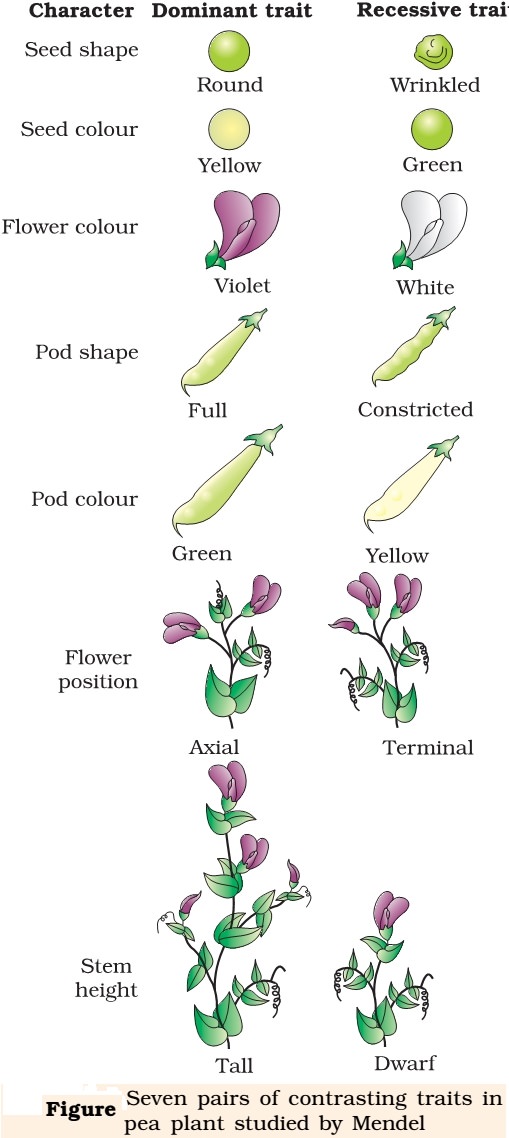
- Let us take the example of one such hybridisation experiment carried out by Mendel where he crossed tall and dwarf pea plants to study the inheritance of one gene.
- He collected the seeds produced as a result of this cross and grew them to generate plants of the first hybrid generation. This generation is also called the Filial1 progeny or the F1.
- Mendel observed that all the F 1 progeny plants were tall, like one of its parents; none were dwarf.

- He made similar observations for the other pairs of traits – he found that the F 1 always resembled either one of the parents, and that the trait of the other parent was not seen in them.
- Mendel then self-pollinated the tall F1 plants and to his surprise found that in the Filial 2 generation some of the offspring were 'dwarf'; the character that was not seen in the F 1 generation was now expressed.
- The proportion of plants that were dwarf were 1/4th of the F 2 plants while 3/4th of the F2 plants were tall.
- The tall and dwarf traits were identical to their parental type and did not show any blending, that is all the offspring were either tall or dwarf, none were of in between height.
- Similar results were obtained with the other traits that he studied: only one of the parental traits was expressed in the F1 generation while at the F 2 stage both the traits were expressed in the proportion 3:1. The contrasting traits did not show any blending at either F1 or F2 stage.
Factors – Genes
- Based on these observations, Mendel proposed that something was being stably passed down, unchanged, from parent to offspring through the gametes, over successive generations. He called these things as 'factors'.
- Now we call the 'factors' as genes. Genes, therefore, are the units of inheritance. They contain the information that is required to express a particular trait in an organism.
Pair of Alleles – Homozygous and Heterozygous
- Genes which code for a pair of contrasting traits are known as alleles, i.e., they are slightly different forms of the same gene.
- If we use alphabetical symbols for each gene, then the capital letter is used for the trait expressed at the F 1 stage and the small alphabet for the other trait.
- For example, in case of the character of height, T is used for the Tall trait and t for the 'dwarf', and T and t are alleles of each other. Hence, in plants the pair of alleles for height would be TT, Tt or tt.
- Genotype and Phenotype == TT and tt are called the genotype of the plant while the descriptive terms tall and dwarf are the phenotype.
- Mendel proposed that in a true breeding, tall or dwarf pea variety the allelic pair of genes for height are identical or homozygous, TT and tt, respectively. On the other hand, the allelic pair Tt is heterozygous.
- From the observation that the recessive parental trait is expressed without any blending in the F2 generation, we can infer that, when the tall and dwarf plant produce gametes, by the process of meiosis, the alleles of the parental pair separate or segregate from each other and only one allele is transmitted to a gamete.
- This segregation of alleles is a random process and so there is a 50 per cent chance of a gamete containing either allele, as has been verified by the results of the crossings. In this way the gametes of the tall TT plants have the allele T and the gametes of the dwarf tt plants have the allele t.
- During fertilisation the two alleles, T from one parent say, through the pollen, and t from the other parent, then through the egg, are united to produce zygotes that have one T allele and one t allele. In other words the hybrids have Tt. Since these hybrids contain alleles which express contrasting traits, the plants are heterozygous.
Dominant and Recessive Factor
- What twould be the phenotype of a plant that had a genotype Tt? As Mendel found the phenotype of the F1heterozygote Tt to be exactly like the TT parent in appearance, he proposed that in a pair of dissimilar factors, one dominates the other (as in the F1) and hence is called the dominant factor while the other factor is recessive.
- In this case T (for tallness) is dominant over t (for dwarfness), that is recessive. He observed identical behaviour for all the other characters/trait-pairs that he studied.
- It is convenient (and logical) to use the capital and lower case of an alphabetical symbol to remember this concept of dominance and recessiveness.
- Alleles can be similar as in the case of homozygotes TT and tt or can be dissimilar as in the case of the heterozygote Tt.
- Since the Tt plant is heterozygous for genes controlling one character (height), it is a monohybrid and the cross between TT and tt is a monohybrid cross.
Punnett Square for Monohybrid Cross
- The production of gametes by the parents, the formation of the zygotes, the F1 and F2 plants can be understood from a diagram called Punnett Square as shown in Figure below.
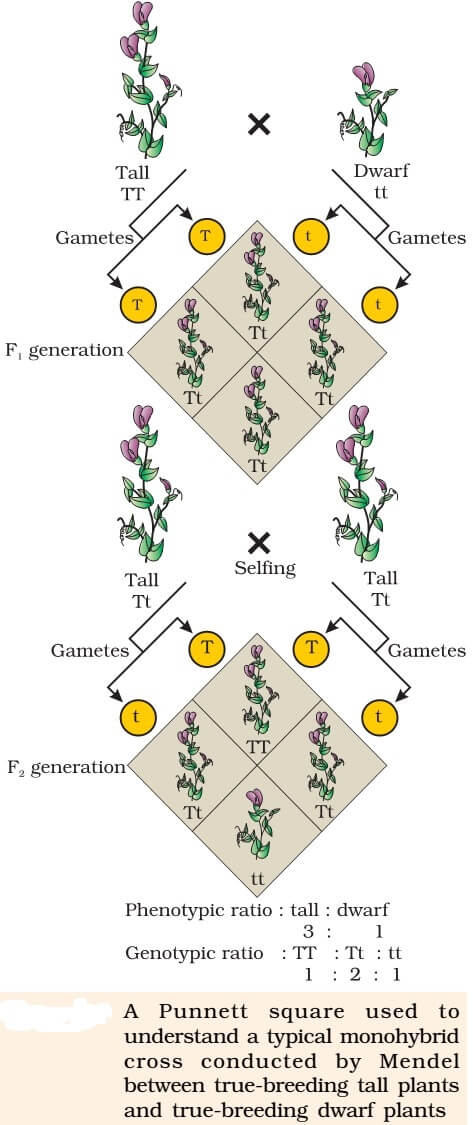
- The Punnett Square above shows the parental tall TT (male) and dwarf tt (female) plants, the gametes produced by them and, the F1 Tt The F1 plants of genotype Tt are self-pollinated.
- The F1 plant of the genotype Tt when self-pollinated, produces gametes of the genotype T and t in equal proportion.
- When fertilisation takes place, the pollen grains of genotype T have a 50 per cent chance to pollinate eggs of the genotype T, as well as of genotype t.
- Also pollen grains of genotype t have a 50 per cent chance of pollinating eggs of genotype T, as well as of genotype t. As a result of random fertilisation, the resultant zygotes can be of the genotypes TT, Tt or tt.
- From the Punnett square it is easily seen that 1/4th of the random fertilisations lead to TT, 1/2 lead to Tt and 1/4th to tt.
- Though the F1 have a genotype of Tt, but the phenotypic character seen is 'tall'.
- At F2, 3/4th of the plants are tall, where some of them are TT while others are Tt.
Test Cross
- Externally it is not possible to distinguish between the plants with the genotypes TT and Tt. Hence, within the genopytic pair Tt only one character 'T' tall is expressed. Hence the character T or 'tall' is said to dominate over the other allele t or 'dwarf' character.
- It is thus due to this dominance of one character over the other that all the F 1 are tall (though the genotype is Tt) and in the F2 3/4th of the plants are tall (though genotypically 1/2 are Tt and only 1/4th are TT).
- This leads to a phenotypic ratio of 3/4th tall : (1/4 TT + 1/2 Tt) and 1/4th tt, i.e., a 3:1 ratio, but a genotypic ratio of 1:2:1.
- The genotypic ratios can be calculated by simply looking at the phenotype of a dominant trait but it is not possible to know the genotypic composition.
- That is, for example, whether a tall plant from F1 or F 2 has TT or Tt composition, cannot be predicted.
- Therefore, to determine the genotype of a tall plant at F2, Mendel crossed the tall plant from F2 with a dwarf plant. This he called a test cross.
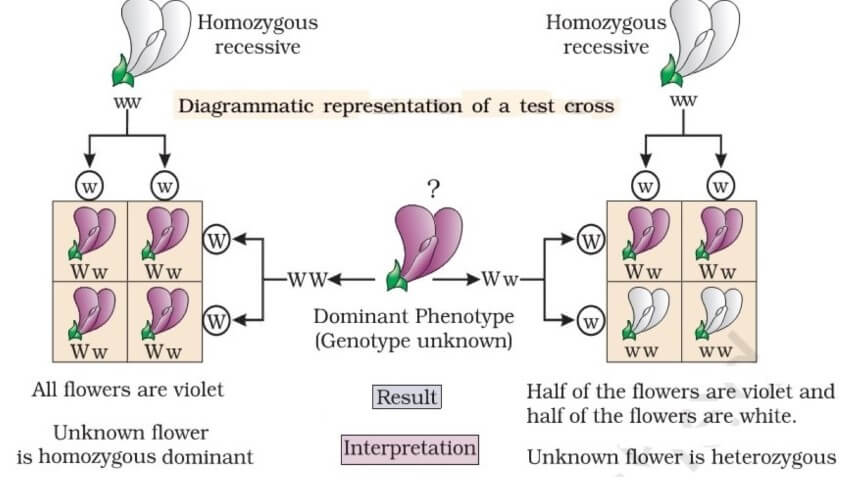
- In a typical test cross an organism (pea plants here) showing a dominant phenotype (and whose genotype is to be determined) is crossed with the recessive parent.
- The progenies of such a cross can easily be analysed to predict the genotype of the test organism.
- Figure shows the results of typical test cross where violet colour flower (W) is dominant over white colour flower (w).
Mendel's Laws of Inheritance
- Based on his observations on monohybrid crosses Mendel proposed two general rules to consolidate his understanding of inheritance in monohybrid crosses.
- Today these rules are called the Principles or Laws of Inheritance: the First Law or Law of Dominance and the Second Law or Law of Segregation.
First Law or Law of Dominance
- Characters are controlled by discrete units called factors.
- Factors occur in pairs. [pair of alleles]
- In a dissimilar pair of factors one member of the pair dominates (dominant) the other (recessive).
- The law of dominance is used to explain the expression of only one of the parental characters in a monohybrid cross [Mendel's Experiments on Inheritance] in the F1 and the expression of both in the F 2. It also explains the proportion of 3:1 obtained at the F2.
Second Law or Law of Segregation
- This law is based on the fact that the alleles do not show any blending and that both the characters are recovered as such in the F 2 generation though one of these is not seen at the F1 stage.
- Though the parents contain two alleles during gamete formation, the factors or alleles of a pair segregate from each other such that a gamete receives only one of the two factors [either dominant or recessive].
- Of course, a homozygous parent produces all gametes that are similar while a heterozygous one produces two kinds of gametes each having one allele with equal proportion.
Incomplete Dominance
- When experiments on peas were repeated using other traits in other plants, it was found that sometimes the F 1 had a phenotype that did not resemble either of the two parents and was in between the two.
- The inheritance of flower colour in the dog flower (snapdragon or Antirrhinum sp.) is a good example to understand incomplete dominance.
- In a cross between true-breeding red-flowered (RR) and truebreeding white-flowered plants (rr), the F1 (Rr) was pink. When the F1 was self-pollinated the F 2 resulted in the following ratio 1 (RR) Red : 2 (Rr) Pink: 1 (rr) White.
- Here the genotype ratios were exactly as we would expect in any mendelian monohybrid cross, but the phenotype ratios had changed from the 3:1 dominant : recessive ratio.
- What happened was that R was not completely dominant over r and this made it possible to distinguish Rr as pink from RR (red) and rr (white).
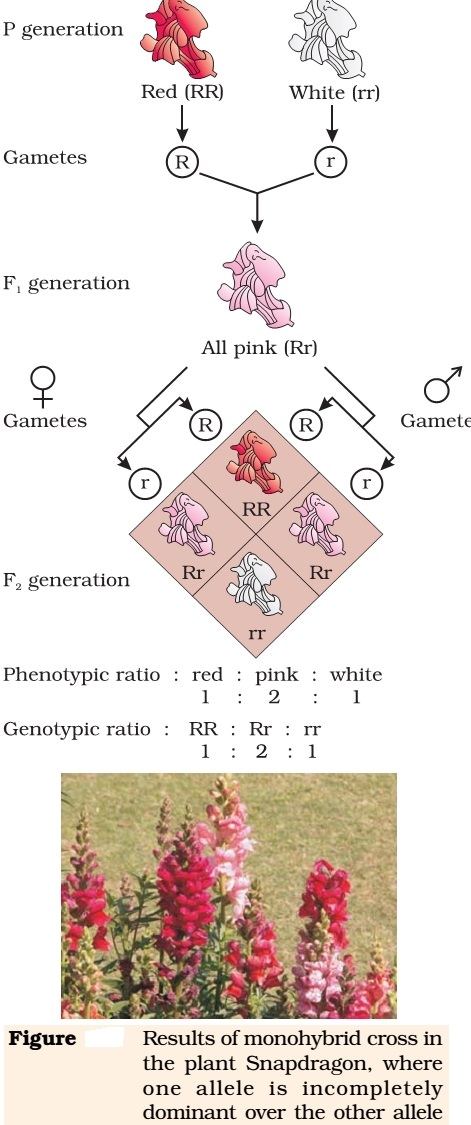
Co-dominance
- Till now we were discussing crosses where the F1 resembled either of the two parents (dominance) or was in-between (incomplete dominance). But, in the case of co-dominance the F 1 generation resembles both parents.
- A good example is different types of red blood cells that determine ABO blood grouping in human beings.
- ABO blood groups are controlled by the gene I. The plasma membrane of the red blood cells has sugar polymers that protrude from its surface and the kind of sugar is controlled by the gene. The gene (I) has three alleles IA, IB and i.
- The alleles IA and IB produce a slightly different form of the sugar while allele i does not produce any sugar.
- Because humans are diploid organisms, each person possesses any two of the three I gene alleles.
- IA and IB are completely dominant over i, in other words when IA and i are present only IA expresses (because i does not produce any sugar), and when IB and i are present IB expresses.
- But when IA and IB are present together they both express their own types of sugars: this is because of co-dominance. Hence red blood cells have both A and B types of sugars.
- Since there are three different alleles, there are six different combinations of these three alleles that are possible, and therefore, a total of six different genotypes of the human ABO blood types. How many phenotypes are possible?
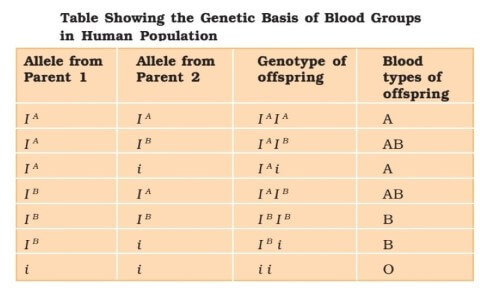
Here there are 6 Genotypes and 4 Phenotypes [A, B, AB and O].
Inheritance of Two Genes – Dihybrid Cross
- Mendel also worked with and crossed pea plants that differed in two characters, as is seen in the cross between a pea plant that has seeds with yellow colour and round shape and one that had seeds of green colour and wrinkled shape.
- Yellow colour was dominant over green and round shape dominant over wrinkled.
- Let us use the genotypic symbols Y for dominant yellow seed colour and y for recessive green seed colour, R for round shaped seeds and r for wrinkled seed shape.
- The genotype of the parents can then be written as RRYY and rryy. The cross between the two plants can be written down as in Figure showing the genotypes of the parent plants.
- The gametes RY and ry unite on fertilisation to produce the F1 hybrid RrYy.
- When Mendel self hybridised the F1 plants he found that 3/4th of F2 plants had yellow seeds and 1/4th had green.
- The yellow and green colour segregated in a 3:1 ratio. Round and wrinkled seed shape also segregated in a 3:1 ratio; just like in a monohybrid cross.
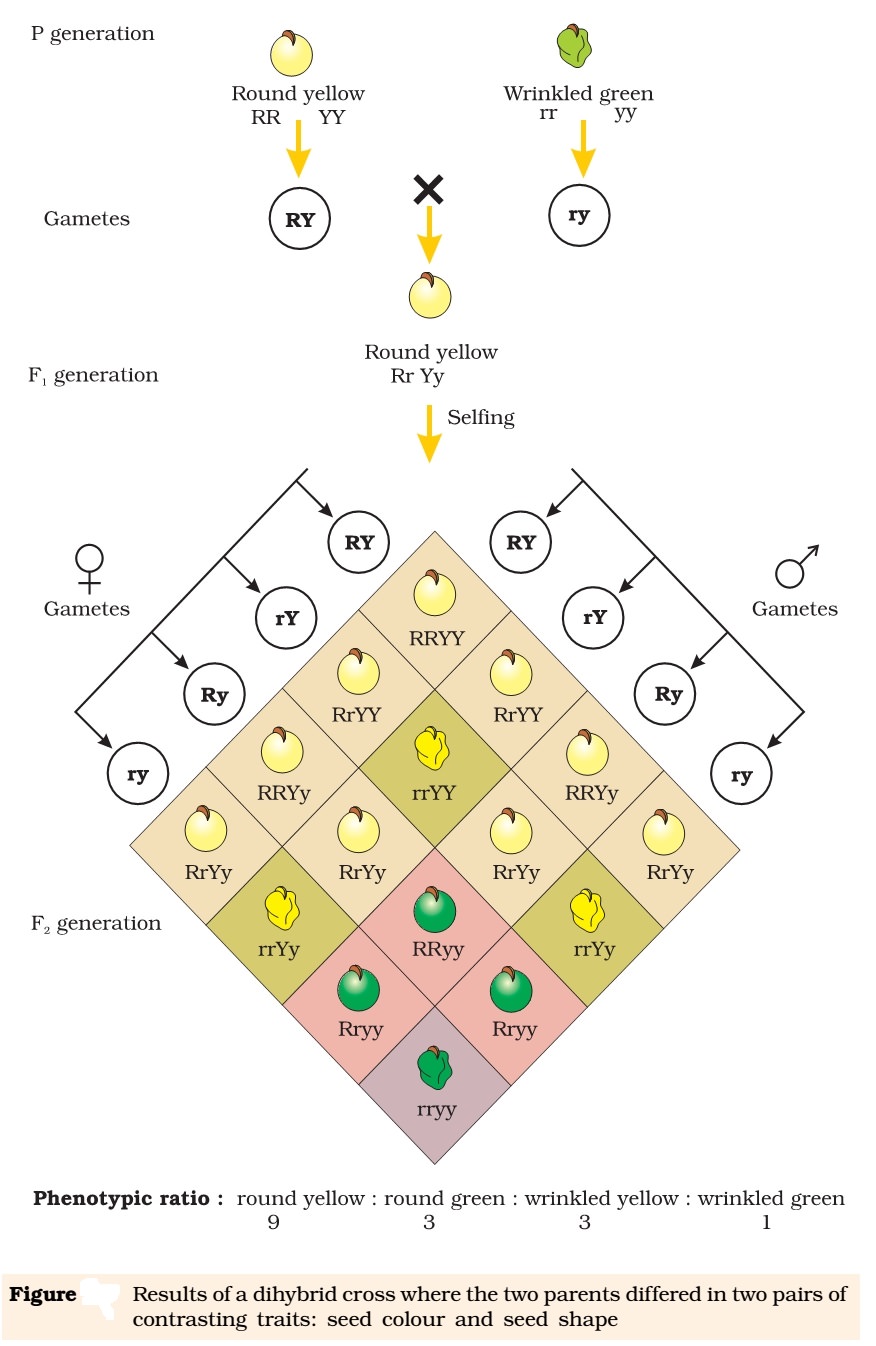
Law of Independent Assortment
- In the dihybrid cross, the phenotypes round, yellow; wrinkled, yellow; round, green and wrinkled, green appeared in the ratio 9:3:3:1.
- Such a ratio was observed for several pairs of characters that Mendel studied. The ratio of 9:3:3:1 can be derived as a combination series of 3 yellow: 1 green, with 3 round : 1 wrinkled. This derivation can be written as follows: (3 Round : 1 Wrinkled) (3 Yellow : 1 Green) = 9 Round, Yellow : 3 Wrinkled, Yellow: 3 Round, Green : 1 Wrinkled, Green.
- Based upon such observations on dihybrid crosses (crosses between plants differing in two traits) Mendel proposed a second set of generalisations that we call Mendel's Law of Independent Assortment.
- The law states that 'when two pairs of traits are combined in a hybrid, segregation of one pair of characters is independent of the other pair of characters'.
- You can verify the law using The Punnett square above [Inheritance of Two Genes – dihybrid cross].
Summary
- Genetics is a branch of biology which deals with principles of inheritance and its practices.
- Progeny resembling the parents in morphological and physiological features has attracted the attention of many biologists.
- Mendel was the first to study this phenomenon systematically. While studying the pattern of inheritance in pea plants of contrasting characters, Mendel proposed the principles of inheritance, which are today referred to as 'Mendel's Laws of Inheritance'.
- He proposed that the 'factors' (later named as genes) regulating the characters are found in pairs known as alleles.
- He observed that the expression of the characters in the offspring follow a definite pattern in different–first generations (F1), second (F2) and so on. Some characters are dominant over others.
- The dominant characters are expressed when factors are in heterozygous condition (Law of Dominance). The recessive characters are only expressed in homozygous conditions.
- The characters never blend in heterozygous condition.
- A recessive character that was not expressed in heterozygous condition may be expressed again when it becomes homozygous. Hence, characters segregate while formation of gametes (Law of Segregation).
- Not all characters show true dominance. Some characters show incomplete, and some show co-dominance.
- When Mendel studied the inheritance of two characters together, it was found that the factors independently assort and combine in all permutations and combinations (Law of Independent Assortment).
- Different combinations of gametes are theoretically represented in a square tabular form known as 'Punnett Square'.
- The factors (now known as gene) on chromosomes regulating the characters are called the genotype and the physical expression of the characters is called phenotype.
Newsletter Updates
Subscribe to our newsletter and never miss an important update !!
What Attributes Of The Garden Pea Plant Made It An Excellent Organism Fo R Gregor Medenls Study
Source: https://www.pmfias.com/inheritance-mendels-laws-of-inheritance-mendels-experiments-on-inheritance/
Posted by: millardfornow38.blogspot.com

0 Response to "What Attributes Of The Garden Pea Plant Made It An Excellent Organism Fo R Gregor Medenls Study"
Post a Comment